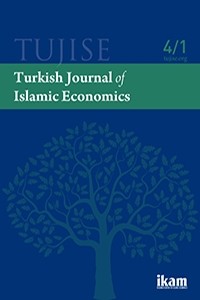PİYASALARIN AYRIŞMASI VE MALİ İSTİKRARSIZLIK: KLASİK DİKOTOMİYE YAKIN BİR BAKIŞ
Son otuz yıl içerisinde bir kaç mali krizin meydana gelmesi, mali piyasaların libarelleşmesi ve serbestleşmesi literatüründeki tartışmayı ateşledi. Bu makalede mali ve reel sektör ayrışması kavramı klasik dikotomi teorisi ve eleştirileri taranarak takdim edilmektedir. Bu ayrımın varlığının ve ayrımın genişlemesinin mali krize yol açacağı iddia edilmektedir. Ayrımı ortaya koymak için Fiyat-Kazanç Oranı indeksi verilmektedir. 2002:2-2015:1 tarihleri arasında Tahran Menkul Kıymetler Borsası verilerini kullandığımızda bu piyasa ayrışmasının varlığına işaret eden bir kaç vakanın olduğu görülmektedir. Mali ayrışmayı azaltmak ve dolayısıyla mali krizlerden korunmak için piyasa ayrışmasına yol açan faktörleri göz önünde bulundurarak düzenleyici kuralların yeniden ihdas edilmesi gerekmektedir. Bu bakış açısıyla, İslami mali kurallar, reel ve mali sektörler arasında ahenk kuran bir ekonomik sistem sunabilmektedir.Anahtar Kelimeler: mali piyasalar, spekülasyon, fiyat şişmesi, ayrışma, mali kriz
Anahtar Kelimeler:
mali piyasalar, spekülasyon, fiyat şişmesi, ayrışma, mali kriz
SEPARATION OF MARKETS AND FINANCIAL INSTABILITY: A CLOSER LOOK TO CLASSICAL DICHOTOMY
Several financial crises occurred over the past three decades have provoked debates in the literature of liberalization and deregulation of financial markets. By surveying the theory of classical dichotomy and its critiques, the notion of “separation” between the financial and real sectors has been introduced in this paper. It argues that the existence and expansion of this separation will lead to financial crisis.In order to identify the separation “price-to-earnings ratio” index has been proposed. By applying the data of Tehran’s Stock Exchange during 2002:2-2015:1, several episodes of this separation are recognizable. Considering the factors causing the expansion of the separation, it is essential to reestablish regulations and mechanisms of financial markets in a way that reduces the separation and hence lessen financial crises. In this view, Islamic financial rules can provide an economic system with mechanisms bringing harmony between the real and the financial sectors.Keywords: financial markets, speculation, price bubble, separation, financial crisis
___
- Athanasoglou, P. P., Daniilidis, I., & Delis, M. D. (2014). Bank procyclicality and output: Issues and policies. Journal of Economics and Business, 72, 58-83.
- Becker, G. S., & Baumol, W. J. (1952). The classical monetary theory: the outcome of the discussion. Economica, 19(76), 355-376.
- Becker, R., Lee, J., & Gup, B. E. (2012). An empirical analysis of mean reversion of the S&P 500’s P/E ratios. Journal of Economics and Finance,36(3), 675-690.
- Binswanger, M. (1999). Stock markets, speculative bubbles and economic growth. Books.
- Campbell, J. Y., & Shiller, R. J. (1998). Valuation ratios and the long-run stock market outlook. The Journal of Portfolio Management, 24(2), 11-26.
- Central bank of Iran (2016), Economic Trends Report, http://www.cbi.ir/default_en.aspx
- Chapra, M. U. (2009). The global financial crisis can Islamic finance help?. Insights, 1(4), 27.
- Claessens, S., Kose, M. A., & Terrones, M. E. (2010, September). Financial Cycles: What? How? When?. In NBER International Seminar on Macroeconomics 2010 (pp. 303-343). University of Chicago Press.
- el-Din, S. I. T. (2012). From the Great Depression to the 2008 Global Financial Crisis: Systemic Flaws in Investment Financing. SABIC Chair for IFMS.
- Hadian, M., Davoudi, P. (2016). Interest rate and financial instability. Journal of Islamic Finance, Vol. 5 No. 1, 001 – 011.
- Keynes, J. M. (2006). General theory of employment, interest and money. Atlantic Publishers & Dist.
- Lucas, R. E. (1972). Expectations and the Neutrality of Money. Journal of economic theory, 4(2), 103-124.
- Minsky, H. P. (1992). The financial instability hypothesis. The Jerome Levy Economics Institute Working Paper, (74).
- Patinkin, D., & Steiger, O. (1989). In Search of the "Veil of Money" and the "Neutrality of Money": A Note on the Origin of Terms. The Scandinavian Journal of Economics, 91(1), 131-146.
- Reinhart, C. M., & Rogoff, K. (2009). This time is different: eight centuries of financial folly. Princeton university press.
- Shiller, R. J. (2000). Measuring bubble expectations and investor confidence. The Journal of Psychology and Financial Markets, 1(1), 49-60.
- Shiller, Robert (2016), online data, http://www.econ.yale.edu/~shiller/data.htm
- Siddiqi, M. N. (2009). Current financial crisis and Islamic economics. Insights, 1(3), 141.
- Tehran Stock Exchange (2015), Market indices, http://new.tse.ir/en/
- World Bank, (2016), open data, http://data.worldbank.org/
- Başlangıç: 2014
- Yayıncı: Research Center for Islamic Economics (ikam)
Sayıdaki Diğer Makaleler
RİBA (FAİZ); FİNANSAL İŞLEMLERDEN ÇIKARILMASI GEREKEN BİR ARAÇ
PİYASALARIN AYRIŞMASI VE MALİ İSTİKRARSIZLIK: KLASİK DİKOTOMİYE YAKIN BİR BAKIŞ
SUKUK FİNANSMANI İKTİSADİ BÜYÜMEYİ TEŞVİK EDER Mİ? SUKUK ÇIKARAN ANA ÜLKELER ÜZERİNE BİR ÇALIŞMA
Abdelghani ECHCHABI, Hassanuddeen ABD.AZIZ, Umar IDRISS
HURŞİD AHMET’İN İKTİSAT DÜŞÜNCESİ
